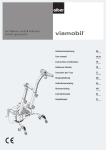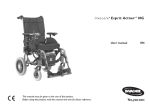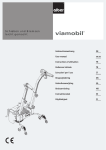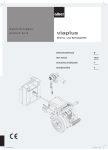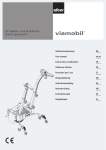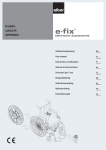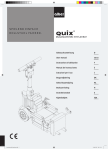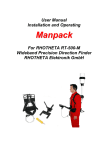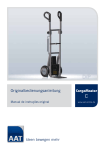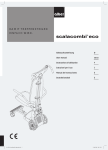Download User Manual - John Preston Healthcare Group
Transcript
Einfach sicher Treppensteigen. GA S35 Umschlag alle Sprachen.in5 5 Gebrauchsanweisung D User manual GB/US Instructions d’utilisation F Manual de instrucciones E Istruzioni per l‘uso I Instruktionsbok S Gebruiksaanwijzing NL Brugsvejledning DK 07.10.2010 14:48:58 5 4 3 1 2 5 22 23 24 3 6 4 1 25 7 28 27 13 26 8 29 30 21 9 20 31 19 10 18 11 12 13 33 14 34 35 15 17 16 GA S35 Umschlag alle Sprachen.in1 1 32 07.10.2010 14:48:55 Contents 1. Introduction 1.1 Important safety notes 1.2 Proper use of the scalamobil 1.3 Permissible operating conditions / locations of operation 1.4 Standard scope of delivery 1.5 Optional accessories 1.6 Stairs suitable for scalamobil 1.7 Technical data 1.8 The main elements at a glance 2. Start-up 2.1 Adjusting the scalamobil to suit the operator 2.2 Adjusting the scalamobil to the stairs to be climbed 2.3 Control elements at the drive 2.3.1 Speed regulator 2.3.2 Drive mode selection switch 2.3.3 Single step mode 2.3.4 Soft Step function 2.4 Control elements on the handle 2.4.1 Switching on the scalamobil 2.4.1 Switching off the scalamobil 2.4.3 Display symbols 2.4.4 Preselecting climbing direction 2.4.5 Driving switch 2.5 Function check 2.5.1 Aligning the wheels 2.5.2 Brake test 2.6 Attaching the scalamobil to the wheelchair 2.6.1 Manual insertion 2.6.2 Insertion with motor power 2.6.3 Inserting the quickpins 2.6.4 Removing the quickpins 2.7 Removing the wheels from the wheelchair 2.8 Removing the scalamobil from the wheelchair 3. Climbing stairs 3.1 Climbing up stairs GA-S35_englisch.indd 1 2 2 2 3 3 3 3 4 4 5 6 6 7 7 7 8 8 8 8 9 9 9 9 10 11 11 12 12 12 13 13 13 14 15 15 3.2 Climbing down stairs 3.3 Climbing spiral staircases 3.4 Climbing metal grid stairs 3.5 Halting the scalamobil while climbing stairs 3.6 Driving a wheelchair with attached scalamobil 3.7 Special safety instructions for the climbing of stairs 4. Anti-theft protection 4.1. Activating anti-theft protection 4.2. Deactivating anti-theft protection 5. Automatic shut-down 6. Batteries 6.1 Charging the battery pack 6.2 Removing the battery pack 6.3 Batteries used in the scalamobil 7. Transport and storage 7.1 Dismantling the scalamobil 7.2 Assembling the scalamobil 7.3 Instructions for storage and transportation 7.3.1 Important safety note 7.3.2 Securing the scalamobil during transport 8. Display and error messages 9. Troubleshooting in the event of a malfunction 10. Safety and hazard information 10.1. General safety and hazard information 10.2 Safety signs and instructions attached to the scalamobil 11. Care and cleaning instructions, safety inspections (maintenance), re-use and disposal 11.1 Care and cleaning instructions 11.2 Safety inspections (maintenance) 11.3 Re-use 11.4 Disposal 12 Warranty and liability 12.1 Warranty for defects 12.2 Guarantee of durability 12.3 Liability 16 17 17 18 18 19 20 20 20 20 21 21 21 22 23 23 23 24 24 24 25 25 25 25 27 27 27 27 28 28 28 28 28 28 07.10.2010 11:24:27 8 1. Introduction 1.1 Important safety notes– please observe carefully at all times The scalamobil is a mobile stair climber. For safety reasons, it must only be operated by persons who • have been instructed in its handling • who can climb stairs backwards • can lift at least 20 % of their own bodyweight • have the physical and mental capacity to operate the device safely in all possible situations. A one-to-one instruction session for the handling and operation of the device is included in the scope of delivery. Please contact your authorised dealer or Ulrich Alber GmbH agent to arrange for a training session. The instruction is free of charge. If you feel a little unsure how to handle the scalamobil, please contact your authorised dealer or Ulrich Alber GmbH agent for advice. In the event of a technical fault or failure, contact your authorised dealer or an agent of Ulrich Alber GmbH. The performance of the scalamobil can be affected by electromagnetic fields that are produced for example by mobile phones. Therefore switch off the scalamobil if a mobile phone is used in the vicinity of the device. Persons using the wheelchair and operators must not use a mobile phone during stair climbing. We generally recommend refraining from using the scalamobil in locations that are exposed to strong electric fields. When in operation, the scalamobil might under certain circumstances interfere with other electrical equipment such as antishoplifting barriers in department stores. When using a scalacombi S36 with integrated seat or the scalaport X7 universal adapter, always adhere to the enclosed operating and installation instructions. ! Do not start the scalamobil before you have been properly instructed in its operation by an authorised dealer! 1.2 Proper use of the scalamobil The scalamobil has been designed exclusively for conveyance of persons with a walking disability over steps; please note that you must not convey a person with a walking disability on escalators or moving walkways. It is forbidden to make any technical modifications to the device. Do not attach any parts other than accessories approved by Ulrich Alber GmbH for operation with the scala mobil. The scalamobil must only be operated under the following conditions: • Full compliance with the information, instructions, and recommendations contained in this operating manual. • The device is operated by a person who has been instructed in its use. • No technical modifications have been made to the device by the user or by any third party. • The person to be transported is able sit on the scalamobil without the need for assistance. • The operator must check whether it is necessary to use a lap belt and / or the foot belt. • During transportation, the arms of the person being conveyed must not project over the armrests of the wheelchair. A trained operator is a person who has been instructed in the operation of the scalamobil and in related tasks and who has been made aware of the possible hazards associated with the improper use of the device. The instruction session is provided by the authorised dealer or by an agent of Ulrich Alber GmbH. The operation of the scalamobil by non-instructed or unqualified persons is strictly prohibited. The scalamobil must not be used for transportation tasks that contravene the intended use of the stair climber. This applies in particular to any types of load transport such as the transport of goods and objects over steps. The use of the scalamobil for any of the following purposes is deemed improper by Ulrich Alber GmbH: • Use or operation of the device that contravenes the instructions and recommendations in this operating manual. • Exceedance of the technical limits laid down in this operating manual. • Technical modifications to the stair climber. • Attachment and/or use of parts and accessories that have not been supplied or approved by Ulrich Alber GmbH. Ulrich Alber GmbH shall not be liable for damage caused by improper use of the stair climber. GA-S35_englisch.indd 2 07.10.2010 11:24:27 While being conveyed on stairs, the person sitting in the wheelchair must remain still. Please note that, when transporting persons with certain disabilities, there might be uncontrolled body movements so that the centre of gravity of the scalamobil might be shifted during transportation. The operator should be capable at all times to react to such sudden movements of the person being conveyed. It is therefore up to the person operating the scalamobil to decide whether a person can be safely transported on the stair climber. 1.3 Permissible operating conditions / locations of operation The scalamobil must only be used for the climbing of stairs at ambient temperatures between –25 °C and +50 °C. Under certain circumstances, the device is also suitable as a transfer system for short-distance travel across a level path to and from stairs. Never release the scalamobil when on a staircase. Do not tilt the stair climber backwards, unless this is required in the event of an emergency. Ensure that the surface on which the scalamobil is to be used is not wet, waxed or otherwise slippery. Carpets must be installed so that they cannot slip. The step height must not exceed 20 cm. The minimum step depth should not be less than 11 cm. Please always observe the safety and hazard information in chapter 10. 1.4 Standard scope of delivery • 1 scalamobil stair climber, fully assembled and ready for operation • 1 charger including operating manual • Key for anti-theft protection • Operating manual 1.5 Optional accessories • Headrest • Lap belt • Foot belt • Scalaport X7 • Scala-chair X3 • Car charger • Wheel transport bracket We recommend using only original accessories supplied by Ulrich Alber GmbH. The scalamobil is designed in such a way that best performance is achieved when using Alber original accessories. Ulrich Alber GmbH shall not be liable for damage to the product or accidents (e.g. fire due to explosion of the battery pack, leaks, etc.) caused by a malfunction of non-original accessories or spare parts. The warranty does not cover repairs for damage caused by the malfunction of non-original accessories. Ulrich Alber GmbH will however carry out such repairs for you against a charge. 1.6 Stairs suitable for scalamobil The scalamobil can climb stairs of the following dimensions: • Minimum step depth: 11 cm • Maximum step height: 20 cm • Minimum step width of straight stairs: 55 cm (*) • Minimum landing size of U-shaped staircases: 1.35 m (*) • Minimum radius of spiral staircases: 1.35 m (*) (*) depending on wheelchair model GA-S35_englisch.indd 3 07.10.2010 11:24:27 8 1.7 Technical data Floor clearance of drive unit: 45 cm Width of drive unit: 37 cm Overall height with attached handlebar: 113 – 117 cm, depending on clamping piece angle Overall width: 43 cm (handles closest together) Weight without handlebar: 20 kg Weight with handlebar: 25 kg Weight of handlebar: 5 kg Max. weight of person (*): 140 kg; with scalaport X7: 120 kg Motor voltage: 24 V Climbing speed (**): approx. 19 steps/minute (without Soft Step) Capacity per battery charge (**): 300 steps Battery pack (integrated in drive unit) Battery type: lead-gel Battery capacity: 3.4 Ah Weight of battery pack: 2.7 kg Battery charger Model / type: BC 2410LA Input voltage: 90 – 265 VAC Rated output voltage: 24 VDC Charging current: 1A Charging method: IU0U Use: Designed exclusively for the recharging of the above battery pack For technical information and user instructions, please refer to the separate operating manual of the battery charger. All electrical components of the scalamobil are protected against spray water and humidity. (*) This value indicates the upper technical limit and depends on the wheelchair model. This value might also be affected by the suitability of the operator. (**) The range and climbing speed vary, depending on the prevailing travel conditions and the weight of the passenger. The specified range is valid for optimum travel conditions (fully recharged batteries, ambient temperature around 20 °C, smooth travel, etc.). The scalamobil conforms to the requirements laid down in the European Medical Device Directive 93/42/EEC. The scalamobil complies with all applicable requirements of ISO 7176-23. We reserve the right to modify the design and technology of our products to incorporate the latest developments. 1.8 The main elements at a glance (Fold open diagram of the scalamobil on the first inside pages of this manual) Handlebar Handle Driving switch Clamping lever Main switch Display Selection switch for climbing direction Support pad Knob for height adjustment Lower knob Drive unit Battery pack locking mechanism Battery pack Charger socket Control compartment GA-S35_englisch.indd 4 1 2 3 4 5 6 7 8 9 10 11 12 13 Control compartment cover Inner wheel Outer wheel Brake Lower bolt Upper bolt Spacer ring Carrying handle 14 15 16 17 18 19 20 21 Display “Climbing up” indicator Battery pack charge warning “Climbing down” indicator Anti-theft indicator 22 23 24 25 Control compartment Control compartment Drive mode selection switch Speed regulator Single step switch 13 26 27 28 Accessories Key for anti-theft protection Charging plug LED display at charger 29 30 31 07.10.2010 11:24:27 2. Start-up The scalamobil and all accessories ordered by you are delivered to you by Ulrich Alber GmbH or your authorised dealer. All the operator needs to do is to adjust the handlebar to the body size of the operator (see chapter 2.1). In addition, special brackets ([34] and [35]) have been attached to your wheelchair. The holders must engage in the scalamobil before the stair climber can be operated (see chapter 2.6). Before using the scalamobil for the first time, you must undergo training provided by your authorised dealer or an agent of Ulrich Alber GmbH. The training covers all aspects of climbing stairs (up and down), and operators will be supervised in the handling and control of the stair climber by the instructor. You will quickly become familiar with the correct operation of the scalamobil and will soon feel comfortable using it on stairs. In addition, you can at all times refer to this operating manual that has been handed over to you together with the stair climber. Apart from technical information, it contains important instructions for the correct and safe use of the scalamobil. Before operating the stair climber on your own, carefully read all instructions in this manual. If you have any questions, please do not hesitate to contact your authorised dealer or an agent of Ulrich Alber GmbH. On your request, these specialists are also able to set up special drive programs for your scalamobil to suit your specific needs (see also chapter 2.3.2). 35 GA-S35_englisch.indd 5 34 ! ! ! The instruction in the operation of the scalamobil must be provided by an authorised dealer or an agent of Ulrich Alber GmbH. ! ! The brackets ([34] and [35]) must be attached to the wheelchair by Ulrich Alber GmbH, its agent or an authorised dealer. Only persons instructed by an authorised dealer or an agent of Ulrich Alber GmbH are authorised to operate the scalamobil. The operation of the scalamobil without prior proper instruction is prohibited. During the instruction in the use of the stair climber, you will be given a lot of useful information on how to operate the scalamobil on stairs. Regularly check the brackets ([34] and [35]) to ensure that they are firmly screwed to the wheelchair. If a screw connection has become loose, contact your authorised dealer or Ulrich Alber GmbH agent to have it retightened. 07.10.2010 11:24:28 8 2.1 Adjusting the scalamobil to suit the operator To ensure correct and comfortable handling of the scalamobil, you must adjust the handle [1] to approximately the shoulder or chest height of the operator. Normally, this adjustment is made by the authorised dealer or agent of Ulrich Alber GmbH upon delivery of the scalamobil. 1 If the height needs to be readjusted at a later stage, please proceed as follows: • Loosen the knobs [8] at the left and right side of the device while holding the handlebar to prevent it from dropping suddenly. • Slide the handlebar up or down to the desired position (corresponding to the shoulder height of the operator, see diagram to the left). • Tighten the knobs [8] on both sides. ! ! The scalamobil must be operated from the rear side of the device (see diagram). Never attempt to start or operate the scalamobil while standing in front of it or from the side. ! When adjusting the height of the handlebar, take special care not to squeeze your hands or fingers in the profile tubes. Regularly check the brackets ([34] and [35]) to ensure that they are firmly screwed to the wheelchair. If a screw connection has become loose, contact your authorised dealer or Ulrich Alber GmbH agent to have it retightened. 8 8 1 3 3 40 cm 2.2 Adjusting the scalamobil to the stairs to be climbed Normally, the two handles [1] are centred on the scalamobil at a distance of approx. 40 cm to each other. The handles can be individually adjusted as follows: • Pull the left of right clamping lever [3] upwards. • Slide the left or right handle [1] to the desired position. • Secure it in this position by pushing the clamping lever [3] again fully into the housing. ! 1 After adjusting the handle, check whether it is properly secured in its position. The handles must not slide unless the clamping lever [3] has been fully released. 3 3 GA-S35_englisch.indd 6 Caution: Risk of injury to fingers and hands from crushing when adjusting the handle position. 07.10.2010 11:24:28 2.3 Control elements at the drive The control elements required for the climbing of stairs with the scalamobil are located at the handlebar and in the control compartment at the rear of the drive unit. The control compartment [13] contains the control elements listed below and can be accessed by opening the hinged cover [14]. 2.3.1 Speed regulator Use the speed regulator [27] to select the speed at which you wish to climb the stairs. Speed range: from 6 steps (lowest speed, switch position 1) to 19 steps (highest speed, switch position 6) per minute (without Soft Step, see chapter 2.3.4) 14 13 ! Avoid fast speeds until you are fully familiar with the operation and handling of the scalamobil. 28 27 26 2.3.2 Drive program selection switch If required, the scalamobil can be configured to suit the stairs you wish to climb. The necessary adjustments are made by an Ulrich Alber GmbH agent or your authorised dealer. For this purpose, the specialist technician determines and enters a number of parameter settings (height of steps of stairs, angle of inclination of scalamobil and climbing speed). These settings are then saved in the “home staircase” mode. When the “home staircase” mode is activated, the person transported with the scalamobil will experience a smoother and more comfortable climb of the stairs. 13 A GA-S35_englisch.indd 7 B If you wish to climb a staircase other than the programmed one, deactivate the “home staircase” mode. The scalamobil is then operated with the factory settings in “standard staircase” mode. • To activate or deactivate the “home staircase” mode, press the selection switch [26]. • Selection switch pushed in (diagram “A”): “home staircase” mode activated • Selection switch released (diagram “B”): “home staircase” mode deactivated 07.10.2010 11:24:28 8 2.3.3 Single step mode To climb stairs (see chapter 3), you must actuate the driving switch [2] on the scalamobil (see chapter 2.4.5). The scalamobil stops only after the driving switch [2] has been released. For experienced users of the scalamobil, it is thus possible to travel without interruption across all stair steps. 28 27 26 13 A B For inexperienced users and when climbing spiral staircases (see chapter 3.3), we have developed the single step mode. In this mode, the scalamobil is set into motion when the driving switch is actuated and stops automatically after a step has been climbed – even if the driving switch [2] remains actuated. To continue climbing, the driving switch must be released and then actuated again. • To set the scalamobil to single step mode, press the single step switch [28]. • Single step switch pushed in (diagram “A”): Single step mode activated • Single step switch released (diagram “B”): Single step mode deactivated i Single step mode prevents inadvertent starting of the climbing movement prior to the proper alignment of the wheels at the edge of the step. It makes climbing stairs even safer for both the person in the wheelchair and the operator. i Upon delivery of the scalamobil, single step mode is activated. 2.3.4 Soft Step function The Soft Step function automatically slows down the speed of the scalamobil motor shortly before the wheels are placed on a step. The speed reduction rate is thereby determined by the selected drive speed. As soon as the step has been climbed, the motor speed is again increased until the next step is reached. This function thus allows for a smoother placing of the scalamobil wheels on the steps of the staircase, enhancing the travel comfort of the wheelchair user. The Soft Step function is integrated into the control program of the scalamobil and is factory-set (i.e. activated). If required, the function can be adjusted to a specific staircase or disabled by your authorised dealer of an Ulrich Alber GmbH agent. 5 6 4 2 2.4 Control elements on the handle 2.4.1 Switching on the scalamobil To switch on the scalamobil, actuate the main switch [4]. The system initially performs a function check and all indicators on the display [5] are lit for a short time. After the function check is completed, the display shows the actual operating status. The main switch [4] is permanently on (green light), and the display [5] shows the currently selected climbing direction. If the scalamobil is not set into motion within 5 minutes after switching it on, it is automatically switched off (see chapter 5). GA-S35_englisch.indd 8 07.10.2010 11:24:29 5 6 2.4.2 Switching off the scalamobil To switch off the scalamobil, press the main switch [4]. All indicators on the display [5] are switched off. After the scalamobil has been switched off, the green light in the main switch [4] is also off. 4 2 22 23 ! i Do not place any garments, bags or other objects on the handles, as they might interfere with the control switches (inadvertent switching on or off). When the scalamobil is switched off, its drive wheels do not automatically return to a specific position. We therefore recommend aligning the drive wheels to each other (see chapter 2.5.1). 2.4.3 Display symbols • “Climbing up” indicator [22] lit in green – “climbing up stairs” mode is preselected. • “Climbing down” indicator [24] lit in green – “climbing down stairs” mode is preselected. • Battery pack charge warning symbol [23] not lit – battery pack charge OK. • Battery pack charge warning symbol [23] flashing red – battery pack charge only 25 %; the battery pack should be recharged as soon as possible. • Battery pack charge warning symbol [23] flashing red and “Climbing down” symbol [24] flashing green – battery pack charge nearly 0 %; climbing stairs is not possible. Select “Climbing down” mode, terminate the current operation and leave the stairs. • Anti-theft symbol [25] flashing yellow – anti-theft protection activated (see chapter 4). • Anti-theft symbol [25] not lit – anti-theft protection deactivated (see chapter 4). 24 25 4 2.4.4 Preselecting climbing direction The selection switch [6] for the climbing direction is located to the left of the handlebar. • To climb up stairs, turn the selection switch [6] to position “up”. • To climb down stairs, turn the selection switch [6] to position “down”. • The climbing direction of the scalamobil can only be changed when the device is standing still. It is thus not possible to change direction while climbing up or down stairs. If the climbing direction switch is actuated while the stair climber is in motion, the climbing movement is halted. The climbing direction changes only after the driving switch [2] has been released. 6 2.4.5 Driving switch Push down the driving switch [2] to set the scalamobil in motion in the direction selected with the selection switch [6]. To stop the scalamobil, release the driving switch [2]. Always hold the scalamobil firmly by its handles and operate the driving switch [2] with your thumb. 2 GA-S35_englisch.indd 9 07.10.2010 11:24:29 8 2.5 Function check As a rule, you should only climb stairs when the batteries are fully charged, as you might otherwise become stuck on the stairs due to empty batteries. For safety reasons, always test the brakes before climbing a staircase. This check must be performed without attached wheelchair and while the scalamobil is switched off. • Check whether the two claming levers [3] are fully pushed into the housing (see also chapter 2.2). • Check, whether the knobs [8] for height adjustment are properly tightened. • Check the two lower knobs [9] on the drive unit to ensure that they are properly tightened. • Ensure that the two inner wheels [15] and the two outer wheels [16] are aligned with each other. If the wheels are not in line with each other, align them manually or automatically (see chapter 2.5.1). • If you are unable to align the wheels with each other, do not use the scalamobil under any circumstances. • Switch off the scalamobil (see chapter 2.4.2). • Carefully move the scalamobil to the edge of the first step. • Slowly push the drive wheels [15] and [16] over the edge of the step. The brakes [17] must now engage to prevent further movement of the scalamobil over the edge. • If the brakes [17] work properly, you can start operating the scalamobil. 8 8 9 9 10 15 16 15 16 ! If one or both brakes [17] fail to work properly, do not operate the scalamobil under any circumstances. First check whether a small object (pebble, etc.) has become caught in the brake system [16] causing the malfunction (see also chapter 11.1). If this is not the case or if the malfunction persists after you have removed the object, the stair climber is defective. Contact your authorised dealer or an agent of Ulrich Alber GmbH without delay. Do not operate the scalamobil until it has been examined by a specialist technician! 16 17 GA-S35_englisch.indd 10 07.10.2010 11:24:29 2.5.1 Aligning the wheels In several chapters of this manual, you are made aware of the correct alignment of the inner [15] and outer [16] wheels. For correct alignment, the four wheels must be fully aligned with each other as shown in the diagram. This alignment ensures that all four wheels are in proper contact with the ground. There are two methods to align the wheels: 16 15 16 Manual alignment • Actuate the driving switch [2] (see chapter 2.4.5) on the handlebar until all four wheels are correctly aligned with each other. The climbing direction (up / down) is thereby irrelevant. Automatic alignment • Set the scalamobil to single step mode [28] (see chapter 2.3.3). • Actuate the driving switch [2] (see chapter 2.4.5) on the handlebar. The climbing direction (up / down) is thereby irrelevant. • The wheels are moved automatically to their correct position. • Release the driving switch [2]. 15 ! 11 2.5.2 Brake test Each inside [15] and outside wheel [16] is equipped with a separate brake [17]. The brake pad [37] is located inside the brake mechanism (see diagram to the left). Regularly check the brake pads [37] and the mating surface [38] in the wheel for dirt. These surface must not be contaminated by dirt (e.g. hairs, carpet fibres, etc.), oil or grease, as this could impair the braking function. 37 38 17 16 GA-S35_englisch.indd 11 If you are unable to align the wheels with each other, do not use the scalamobil under any circumstances. Minor misalignment of the wheels by a few millimetres is however acceptable and might occur for technical reasons. Ensure that all mechanical parts of the brake [17] can be operated easily. Dirt in the brake system might cause the brake to jam. ! Regularly clean the inner [15] and outer [16] wheels, the mating faces of the brake system [38] and the brake pads [37] with methylated spirit. If the scalamobil is used on a daily basis, you should clean these parts once every week. If the stair climber is used less frequently, monthly cleaning might be sufficient. 07.10.2010 11:24:30 8 35 2.6 Attaching the scalamobil to the wheelchair During the instruction session provided by your authorised dealer or an Ulrich Alber GmbH agent, you will be shown how to handle and operate the scalamobil and how to attach it to a wheelchair. The main steps for the attachment of the wheelchair are described here again in detail. • Align the two inner drive wheels [15] and the two outer drive wheels [16] of the scalamobil with each other and carry out a function check (see chapters 2.5 and 2.5.1). • Place the wheelchair to be attached to the scalamobil on a firm and level surface. The wheelchair user may remain seated in the wheelchair. • Apply the parking brakes of the wheelchair so that it cannot roll away. • Slide the scalamobil as shown in the diagram to the left under the wheelchair. Ensure thereby that the scalamobil is in a centre position to the wheelchair. Engage the lower bolts [18] of the scalamobil at the lower brackets [35] on the wheelchair. 18 34 18 When the lower bolts [18] are properly engaged at the two lower brackets [35] on the wheelchair, insert the upper bolts [19] into the forks [34] of the upper brackets of the wheelchair. This can be done in two ways: 35 2.6.1 Manual insertion • Swivel the scalamobil upwards. Insert the two upper bolts [19] into the forks [34] of the upper brackets on both sides of the wheelchair. • Ensure that the spacer rings [20] on the scalamobil are placed firmly against the inside of the fork [34]. • Close the two forks [34] of the upper brackets with a quickpin [32] (see chapter 2.6.3). The two upper bolts [19] must be firmly locked in the forks [34] of the upper brackets. 19 12 34 19 20 2.6.2 Insertion with motor power • Set the speed regulator [27] to a low speed (see chapter 2.3.1). • Set the scalamobil to “climbing up” mode (see chapter 2.4.4). • Actuate the driving switch [2] (see chapter 2.4.5); the scalamobil is now slowly swivelled upwards. • As soon as the two upper bolts [19] are inserted into the two forks [34] of the upper brackets on the wheelchair, release the driving switch [2]. • Ensure that the spacer rings [20] on the scalamobil are placed firmly against the inside of the fork [34]. • Close the two forks [34] of the upper brackets with a quickpin [32] (see chapter 2.6.3). The two upper bolts [19] must be firmly locked in the forks [34]. ! When using the motor to attach the scalamobil to the wheelchair, swivel the stair climber only as far as is necessary to engage the two upper bolts [19] fully in the two forks [34] of the upper brackets, so that they can be locked with the quickpins [32]. Never swivel the scalamobil beyond this point while the bolts are unlocked, as the wheels of the wheelchair might otherwise be lifted off the ground, making it unstable. ! To attach the scalamobil to the wheelchair, you must work on level ground away from the stairs. 34 32 GA-S35_englisch.indd 12 07.10.2010 11:24:30 2.6.3 Inserting the quickpins Hold the quickpin [32] between your index and middle finger as shown in the diagram. Push in the releasing device [33] at the centre of the quickpin, using your thumb. Insert the quickpin through the upper bracket fully into the fork [34] until it reaches the stop. Release the releasing device [33]. The quickpin now locks the fork so that the bolt of the scalamobil cannot become dislodged. 33 34 32 2.6.4 Removing the quickpins Hold the quickpin [32] between your index and middle finger. Push in the releasing device [33] at the centre of the quickpin, using your thumb. Pull the quickpin from the fork [34] of the upper bracket. 34 ! Ensure that the quickpin cannot be inserted into or removed from the fork without pushing in the releasing device [33]. If it can be inserted or removed without pushing in the releasing device, the quickpin is defective and must be replaced without delay. ! If one or both quickpins are defective or not properly locked in the forks, do not attempt to climb stairs. 13 32 36 16 16 GA-S35_englisch.indd 13 2.7 Removing the wheels from the wheelchair After the steps described in the chapters above have been completed, the scalamobil is now ready to climb stairs. Before attempting this, you must however remove the two drive wheels [36] of the wheelchair. • To do this, actuate the driving switch [2] of the scalamobil to lift it together with the attached wheelchair until the two outer drive wheels [16] of the scalamobil are positioned on the ground and the two drive wheels [36] of the wheelchair are lifted off the ground. • Release the parking brakes of the wheelchair. • Remove the two drive wheels [36] of the wheelchair. • Move the two inner wheels [15] and the two outer wheels [16] of the scalamobil until they are aligned with each other (see also chapter 2.5.1). • After all above steps have been completed, you can now climb the stairs. 16 ! WARNING! Never attempt to climb stairs while the drive wheels of the wheelchair are still attached, as this will result in the wheelchair toppling over, causing serious injury! 15 ! While the scalamobil is attached to the wheelchair, the chair‘s centre of gravity might shift, so that the stability of the wheelchair might be impaired. i To take the wheelchair drive wheels with you across the stairs, use the wheel transport bracket available as an accessory for your scalamobil. This bracket is only of use, if there is sufficient space on the stairwell. This means that the wheelchair wheels do not need to be carried separately. 07.10.2010 11:24:31 8 34 15 34 32 33 14 2.8 Removing the scalamobil from the wheelchair After the staircase has been climbed, the scalamobil can remain attached to the wheelchair (observe instructions in chapter 3.6). Alternatively, you can remove the scalamobil from the wheelchair as described below. To operate the wheels [15] and [16], you have the option to set the scalamobil to single step mode (see chapter 2.3.3). • Set the speed regulator [27] to a low speed (see chapter 2.3.1). • Set the scalamobil to “climbing up” mode (see chapter 2.4.4). • Actuate the driving switch [2] (see chapter 2.4.5) and swivel the scalamobil upwards until you can attach the drive wheels [36] of the wheelchair. • Mount the drive wheels [36] on the wheelchair and check them for proper attachment. • Apply the parking brake of the wheelchair so that it cannot roll away. • Set the scalamobil to “climbing down” mode (see chapter 2.4.4). • Actuate the driving switch [2] of the scalamobil to lower it until the two outer wheels [16] and the two wheels of the wheelchair [36] touch the ground. • Remove the quickpins from the forks [34] of the upper brackets (see chapter 2.6.4). • Swivel the upper bolts [19] from the forks [34] of the brackets by actuating the driving switch [2] of the scalamobil. • Keep pushing the driving switch [2] of the scalamobil down until its inner [15] and outer drive wheels [16] are aligned with each other. • Pull the scalamobil from under the wheelchair and store it in a safe place. Ensure that the scalamobil is in a stable position so that it cannot topple over. • Switch off the scalamobil (see chapter 2.4.2). ! To remove the scalamobil from the wheelchair, position the device on firm level ground away from the stairs. 34 19 GA-S35_englisch.indd 14 07.10.2010 11:24:31 3. Climbing stairs During your initial instruction session, you have already learnt how to climb stairs with the scalamobil. You also had the opportunity to complete your first climb under the supervision of the authorised dealer or agent of Ulrich Alber GmbH. Before transporting a person on the scalamobil, you should however read the instructions below and practice the individual steps with the empty wheelchair on a staircase. To transport a person, you might need to use a lap belt or foot belt (optional accessories). It is the responsibility of the operator to check whether this equipment is necessary. Never attach or remove the scalamobil from the occupied or empty wheelchair while standing at the top of the staircase, but move the devices to firm level ground. 3.1 Climbing up stairs • Ensure that the inner [15] and outer [16] drive wheels are aligned with each other (see chapter 2.5.1). • Check again that the person is properly seated on the wheelchair. • Turn the selection switch [6] to position “up” (see chapter 2.4.4). • If the scalamobil is not yet switched on, do this by actuating the main switch [4] (see chapter 2.4.1). • Tilt the scalamobil towards you until it is at an optimum angle to the stairs and the stair climber with the passenger is well balanced. Maintain this angle during the entire climb up the stairs. • Move the scalamobil backwards towards the stairs until the wheels of the scalamobil touch the first step. Move the scalamobil gently and avoid jerking. • To climb up one step, actuate the driving switch [2] (see chapter 2.4.5) while pulling the scalamobil slightly towards the operator. • Do not release the driving switch [2] while the scalamobil is climbing the step. • When the scalamobil has reached the outer edge of the climbed step, release the driving switch [2] and move the scalamobil carefully to the next step. Avoid any jerking movements. • Actuate the driving switch [2] again to climb the next step. • Repeat the above steps until you reach the top of the stairs. • After the last step has been climbed, move the scalamobil to a firm and level surface (do not leave it at the edge of the stairs!). Ensure that the inner [15] and outer [16] drive wheels are aligned with each other (see chapter 2.5.1). • If required, you can now remove the scalamobil from the wheelchair (see chapter 2.8). i GA-S35_englisch.indd 15 15 Set the scalamobil to single step mode (see chapter 2.3.3). In this mode, the climbing process is automatically terminated each time a step has been climbed. 07.10.2010 11:24:31 8 16 17 3.2 Climbing down stairs • Ensure that the inner [15] and outer [16] drive wheels are aligned with each other (see chapter 2.5.1). • Check again that the person is properly seated on the wheelchair. • Turn the selection switch [6] to position “down” (see chapter 2.3.2). • If the scalamobil is not yet switched on, do this by actuating the main switch [4] (see chapter 2.4.1). • Tilt the scalamobil towards you until it is at an optimum angle to the stairs and the stair climber with the passenger is well balanced. Maintain this angle during the entire climb down the stairs. • Carefully move the scalamobil towards the edge of the top step of the stairs until the brakes [17] engage (see diagram to the left). • To move down one step, push down the driving switch [2] (see chapter 2.4.5) and hold it there until the stair climber has been lowered to the next step. Simultaneously the operator has to move the scalamobil slightly forward. • As soon as the inner [15] and outer [16] drive wheels of the scalamobil are positioned on the next lower step, release the main switch [4]. • Ideally, the support pad [7] should thereby rest on your thighs for better control and leverage. • Move the scalamobil gently without jerking towards the edge of the step until the brakes [17] engage. • Actuate the driving switch [2] again to climb down the next step (see chapter 2.4.5). • Repeat the above steps until you reach the bottom of the stairs. • After the last step has been climbed down, move the scalamobil to a firm and level surface (do not leave it at the edge of the stairs!). Ensure that the inner [15] and outer [16] drive wheels are aligned with each other (see chapter 2.5.1). • If required, you can now remove the scalamobil from the wheelchair (see chapter 2.8). i GA-S35_englisch.indd 16 Set the scalamobil to single step mode (see chapter 2.3.3). In this mode, the climbing process is automatically terminated each time a step has been climbed down. 07.10.2010 11:24:32 3.3 Climbing spiral staircases To use the scalamobil on a spiral staircase, follow the operating instructions in chapters 3.1 and 3.2. Please note however that the wheel at the inside of the spiral staircase needs to travel a shorter distance than that on the outside. The scalamobil must be repeatedly realigned with the spiral case during climbing the steps so that the wheels are always in line with the edge of the step to be climbed next. i We strongly recommend climbing spiral staircases in single step mode (see chapter 2.3.3). In this mode, the climbing process is automatically terminated each time a step has been climbed so that the scalamobil can be realigned to the next step. 3.4 Climbing metal grid stairs Special care is required when using the scalamobil on stairs whose steps are made of metal grids! The brakes of the scalamobil might not work properly, especially on stairs with widely spaced metal grids. ! ! GA-S35_englisch.indd 17 Before transporting a person over such stairs, complete a test run with the empty wheelchair. If the brakes become jammed, do not use the scalamobil on the stairs. 17 Never use the scalamobil on wet or slippery metal grid stairs. When using the stair climber on outdoor stairs, ensure that metal grids are not covered in wet leaves or pieces of paper, as they make the steps slippery. Never use the scalamobil on stairs that are obviously slippery. Never use the scalamobil to climb stairs covered in ice. 07.10.2010 11:24:32 8 3.5 Halting the scalamobil while climbing stairs When climbing stairs, do not interrupt the operation of the scalamobil or halt the device mid-stairs. In general, stopping on stairs is only permitted in emergencies, for example if the wheelchair user requires medical attention. If you need to call for assistance, lower the scalamobil on the steps as shown in the diagram to the left. Do not leave the person in the wheelchair alone, and always remain in visual contact. In an emergency, the person in the wheelchair must remain calm, as sudden movements induced by panic might dislodge the stair climber from its position. If the scalamobil is not equipped with a headrest, we strongly recommend that the head of the person in the wheelchair be brought into a comfortable resting position. To do this, you might need to place the head on a cushion made from pieces of clothing. Please note that the scalamobil is automatically shut down when it is not in use for more than 5 minutes. 3.6 Driving a wheelchair with attached scalamobil If required, the scalamobil can remain attached to the wheelchair while moving on level ground. To allow for proper movement, ensure that the inner [15] and outer [16] wheels are aligned with each other (see chapter 2.5.1) so that they do not touch the ground. 18 Please note that the brake [17] protrudes somewhat from the bottom of the stair climber and might collide with obstacles (e.g. kerb stones). Avoid any impact as this could damage the brake [17]. 15/16 17 GA-S35_englisch.indd 18 ! Before using the scalamobil to climb stairs, you must remove the drive wheels from the wheelchair. Never attempt to climb stairs while the drive wheels of the wheelchair are still attached, as this will result in the wheelchair toppling over, causing serious injury! 07.10.2010 11:24:32 3.7 Special safety instructions for the climbing of stairs ! If necessary, secure the feet and legs of the wheelchair user with the foot belt (optional accessory) and tighten a lap belt (optional accessory) around the person‘s waist. ! Ensure that the feet of the wheelchair user are at all times placed on the footrest of the wheelchair. ! The scalamobil may only be switched off when standing on level ground. Only in the event of a serious emergency may it be halted during climbing operation. For details, see chapter 3.5. ! Never use the scalamobil on stairs that are wet, waxed or otherwise slippery. Ensure that stair carpets are properly secured to the floor. The step height must not exceed 20 cm. The minimum step depth should not be less than 11 cm. ! While climbing stairs with the scalamobil, always hold the device with both hands and do not release the handlebar. ! Never attach or remove the scalamobil from the occupied or empty wheelchair while standing at the top of the staircase, but move the devices to firm level ground. ! When using the stair climber on an outdoor stairs, ensure that the steps are not covered in wet leaves or pieces of paper, as they make the steps slippery. Never use the scalamobil on stairs that are obviously slippery. ! Never use the scalamobil to climb stairs covered in ice. ! While climbing stairs, do not reach into the inner [14] or outer [15] wheels of the scalamobil and prevent the wheelchair user from reaching into the wheels. ! Before climbing stairs, keep you hands dry and free of grease or oil. Do not apply hand cream or a similar product. There is a risk that the handles might slip from hands that are greasy. ! Do not wear gloves, as they might become caught in the control elements, especially the driving switch. ! While climbing stairs, the wheelchair user must not hold on to the banister or railing. GA-S35_englisch.indd 19 19 07.10.2010 11:24:32 8 29 4. Anti-theft protection The scalamobil is equipped with an anti-theft device to secure it against unauthorised use or removal. It is operated with the supplied key [29]. 25 4.1 Activating anti-theft protection • Switch on the scalamobil (see chapter 2.4.1). • Place the key [29] on the key symbol [25] on the display. The LED indicator flashes briefly. The scalamobil is now automatically disabled. If the scalamobil is switched on after it has been disabled, the LED indicator of the anti-theft protection [25] flashes in yellow. The stair climbing function is disabled, and the wheels are blocked. 24 23 22 4.2 Deactivating anti-theft protection • Switch on the scalamobil (see chapter 2.4.1). • Place the key [29] on the key symbol [25] on the display. • The LED indicator is switched off and the anti-theft protection is deactivated. The indicator of the currently selected direction [22] or [24] is lit. 20 ! The anti-theft protection can only be activated and deactivated if the scalamobil is switched on. 5. Automatic shut-down The scalamobil shuts down automatically if no function has been actuated within a period of 5 minutes. The device is automatically shut down to save energy. If the handlebar is removed from the drive unit while the scalamobil is switched on, the device is also automatically shut down after 5 minutes. In both cases, the inner [15] and outer [16] drive wheels remain in the position in which they were upon automatic shut-down. When switching on the scala mobil again, it might therefore be necessary to move them to the correct position (parallel alignment). GA-S35_englisch.indd 20 07.10.2010 11:24:33 30 12 30 31 6. Batteries 6.1 Charging the battery pack Your scalamobil is equipped with a powerful battery pack that allows you to climb up to 300 steps without recharging (wheelchair user weight 75 kg). To prevent that the scalamobil runs out of power while climbing stairs, we recommend however to recharge the batteries after each use of the stair climber. To charge the battery pack, it can be removed from the scalamobil. It can however also be charged while installed in the stair climber. • Switch off the scalamobil (see chapter 2.4.2). • Insert the plug [30] of the battery charger [20] into the charger socket [12] of the battery pack. • Then connect the mains plug of the battery charger to a mains socket. Note: Depending on the country in which you are operating the scalamobil, you might need the enclosed adapter to connect the mains plug to the mains socket. • The scalamobil is now being charged. During this process, the LED indicator on the charger [31] indicates the charge level of the batteries. • For more detailed information on the charger and the charging process, please refer to the enclosed operating manual of the charger. • After the charging process is completed, first disconnect the mains plug (or the adapter) of the charger from the mains socket and then disconnect the charging plug [30] from the charger socket [12]. 21 The scalamobil cannot be switched on while it is being charged. Switching on is only possible after the plug of the charger [30] has been disconnected. ! Ensure that the batteries of the scalamobil are recharged after each use of the stair climber. When the batteries are fully recharged, the charger automatically switches to charge conservation mode. Please also observe the instructions in the operating manual enclosed with the charger. To save energy, do not leave the charger connected to the mains for more than 24 hours. Before using the scalamobil, always check the charge status of the batteries to ensure that they are fully charged. 6.2 Removing the battery pack Normally, there is no need to remove the battery pack installed in the housing of the scalamobil. Removal of the battery pack from the drive unit is however recommended when you need to transport your scalamobil (see also chapter 7.3.1). • Push the locking mechanism [10] of the battery pack down. • Pull the battery pack [11] from the housing of the scalamobil. When replacing the battery pack in the housing of the scalamobil, the locking mechanism engages automatically. 10 GA-S35_englisch.indd 21 i The battery pack can be recharged while removed from the scala mobil housing. 07.10.2010 11:24:33 8 22 6.3 Batteries used in the scalamobil The batteries of the scalamobil require no maintenance and are rechargeable. Their service life depends heavily on the number of charging/discharging cycles. Lead batteries can for example be partially charged more than 1000 times and are able to reach their full capacity more than 200 times, provided that deep discharging is prevented. The electronics built into your scalamobil constantly monitor the charge status of the batteries and thus prevent deep discharging. • Prevent the batteries from becoming completely discharged. Recharge the batteries of the scalamobil after each partial discharge, i.e. after each use of the stair climber. • If the batteries are stored (without charging) for a prolonged period of time, they will lose some of their capacity. After a few charging / discharging cycles, the batteries will however regain their full capacity. • The full capacity of new batteries is only reached after about 3 to 4 charging and discharging cycles. • If the batteries are handled incorrectly, there is a risk of liquid electrolyte spilling out. This liquid can cause injury to skin and damage to clothing and equipment. • If eyes or skin has come into contact with electrolyte, immediately rinse the affected area with clean water and consult a doctor. • Do not burn batteries and protect them from naked flames as they can explode when exposed to heat. • Do not short-circuit the batteries. Short-circuits result in high currents, which can cause damage to the batteries and / or the scalamobil. • When the batteries have reached the end of their service life, return them to Ulrich Alber GmbH or your authorised dealer for proper disposal. • We recommend using only batteries supplied by Ulrich Alber GmbH. The scalamobil is designed in such a way that best performance is achieved when using original batteries from Ulrich Alber GmbH. i GA-S35_englisch.indd 22 The batteries of your scalamobil can be discharged and recharged in any chosen position. As regards their safety, they are classified in the same group as dry cell batteries and approved for transport by air by DOT (United States Department of Transportation) and IATA (International Air Transport Association). 07.10.2010 11:24:33 7. Transport and storage 7.1 Dismantling the scalamobil For transport purposes, your scalamobil can be dismantled into individual components without the need for tools. • Remove the battery pack [11] from the housing (see chapter 6.2). • Loosen the two lower knobs [9]. • Pull the handlebar from the drive unit. • Fold up the carrying handle [21] of the drive unit. 8 For transport and storage in confined spaces, the handlebar can be collapsed. • Loosen the two height adjustment knobs [8]. • Slide in the tubes of the height adjustment mechanism. 9 7.2 Assembling the scalamobil To assemble the scalamobil after transport, etc., proceed as follows: • Fold in the carrying handle [21] into the housing. • Slide the tubes of the height adjustment mechanism into the receptacles on the scalamobil. • Tighten the two lower knobs [9]. • Check the tubes of the height adjustment mechanism to ensure that they are properly secured to the scalamobil. It must be impossible to remove the tubes. • Place the battery pack in the housing. 8 9 9 9 ! The two knobs [8] cannot be fully unscrewed from the tubes. To adjust the handlebar height, it is sufficient to loosen them slightly. ! If the tubes of the height adjustment mechanism have been pushed in, the handlebar must again be adjusted to the body size of the operator (see chapter 2.1). ! Do not place the handlebar in an upright position, as it could topple over and become damaged. Therefore place the handlebar horizontally on a level surface. 23 21 GA-S35_englisch.indd 23 07.10.2010 11:24:33 8 7.3 Instructions for storage and transportation 7.3.1 Important safety note For transport and storage, the scalamobil is normally dismantled as described above. If dismantling is not necessary, please proceed as follows: • Before transporting the scalamobil, remove the battery pack [11] to prevent inadvertent start-up of the scalamobil. • When carrying the scalamobil, do not hold it by its inner [15] or outer [16] wheels. • Always hold and carry the scalamobil by its handles [1] and [21]. 1 1 7.3.2 Securing the scalamobil during transport During transport, the scalamobil or its dismantled parts must be properly secured so that they do not pose a risk to the driver or passengers in the event of a sudden brake manoeuvre. To secure the scalamobil in the car, we recommend tying the individual components with suitable straps to the vehicle. Please note that it is the responsibility of the owner to ensure that all components are properly secured and that Ulrich Alber GmbH shall not be held liable for any damage caused by unsecured parts. Please check whether there are specific regulations regarding the transport of the scalamobil or its components in your jurisdiction and strictly adhere to these regulations. 24 Ulrich Alber GmbH and its agents shall not be liable for any damage resulting from non-compliance with these instructions. ! To store the scalamobil, lay it to the ground or position it in such a way that it cannot topple over. 21 GA-S35_englisch.indd 24 07.10.2010 11:24:34 8. Display and error messages The scalamobil is equipped with a number of indicators and symbols on the display (for details, see chapter 2.4.3). 9. Troubleshooting in the event of a malfunction What should I do if ... Remedy the brakes fail to engage properly during the function check? Clean the wheels and the brake drums with methylated spirit. Repeat the function check. the brakes fail to engage properly even after cleaning? Do not operate the scalamobil under any circumstances. your authorised dealer or an agent of Ulrich Alber GmbH. the battery cannot be recharged? This defect can only be repaired at the manufacturer‘s plant. your authorised dealer or an agent of Ulrich Alber GmbH. the scalamobil cannot be switched on? If connected, disconnect the charger. the scalamobil cannot be switched on, although the charger has been disconnected? This defect can only be repaired at the manufacturer‘s plant. your authorised dealer or an agent of Ulrich Alber GmbH. the scalamobil stops working while climbing stairs? Lower the scalamobil backwards to place it on the steps. The automatic safety brakes prevent it from slipping over the edge of the step. a second person to help lifting and moving the scalamobil step by step up or down. the driving switch [2], the selection switch [6] or the main switch [4] is jammed? Do not continue using the scalamobil under your authorised dealer or an agent any circumstances. of Ulrich Alber GmbH. Contact … 25 10. Safety and hazard information 10.1. General safety and hazard information When climbing stairs, the safety and wellbeing of the person being transported on the scalamobil must always have priority. Therefore strictly adhere to all safety instructions in this manual, including the safety notes below. Also comply with the instructions and recommendations given to you during the instruction session with the authorised dealer or agent of Ulrich Alber GmbH. • To transport a person, you might need to use a lap belt or foot belt (optional accessories). It is the responsibility of the operator to check whether this equipment is necessary. • Before and after climbing stairs, realign the inner [14] and outer [15] wheels and the brakes [16] with each other (see chapter 2.5.1). • To prevent inadvertent start-up, always switch off the scalamobil while the wheelchair user is taking place on or leaving the wheelchair. • Should the wheelchair user feel nauseous during the climb, complete the climb as fast as possible and then attend to the person. • As the scalamobil is slightly tilted during the climb, passengers might experience some tension in the neck region. In this case, we recommend attaching the optional headrest available for the scalamobil. • Never release the scalamobil when on a staircase. Do not lower the stair climber onto the steps, unless this is required in the event of an emergency. • When approaching a step, move the scalamobil gently and avoid jerking. When climbing stairs, strictly adhere to the instructions given to your during the initial training session (see chapter 2). • As a general rule, always complete a climb once commenced. Should it however at some time be necessary to interrupt the climb, lower the scalamobil backwards to place it on the staircase. The safety brakes [16] prevent it from slipping over the edge of the step. For details, see chapter 3.5. • During the climb, the wheelchair user should sit still in a relaxed position. In the event of sudden movements by the wheelchair user (e.g. due to his or her medical condition), interrupt the climb immediately. Lower the scalamobil backwards to place it on the steps (see chapter 3.5). Attend to the wheelchair user to calm him/her down before continuing the climb. • Ensure that, during transport and climbing, the wheelchair user keeps his/her arms in a relaxed position on the armrests of the wheelchair. The armrests must not be grabbed by the passenger, as there is a risk that they might be inadvertently pulled from their receptacles. • Only accessories designed specifically for the scalamobil are permitted to be used together with the stair climber. • Never use the scalamobil to climb stairs if they are wet, waxed or otherwise slippery. Do not climb stairs with loose carpet cover. • When using the scalamobil outdoors, do not drive it over wet, slippery or ice-covered ground. Also avoid areas covered in leaves or paper. GA-S35_englisch.indd 25 07.10.2010 11:24:34 8 26 • Special caution is required when using the scalamobil on stairs whose steps are made of metal grids! Before climbing such stairs, complete a test run with the empty wheelchair. If the brakes do not work properly, do not use the scalamobil on the stairs. • The scalamobil must only be used on stairs with a minimum step depth of 11 cm and a maximum step height of 20 cm. • While using the scalamobil, the operator must wear closed shoes with anti-slip soles. • When climbing stairs, never release the handles [1]! • Do not wear gloves, as they might become caught in the control elements, especially the driving switch. • While climbing stairs, the wheelchair user must not hold on to the banister or railing. • When operating or cleaning the scalamobil, never reach into the turning wheels. Also ensure that the passenger does not reach into the turning wheels. • Regularly check the drive system and the brakes to ensure that no foreign objects (e.g. small stones) have become caught in the mechanism. • Before climbing stairs, check the scalamobil to ensure that it is free of dirt and foreign bodies and that the stair climber is in proper working order. • The person operating the scalamobil as well as the wheelchair user may not be under the influence of alcohol or other mindaltering drugs. Medication taken by the operator must not affect that person’s capability to operate the stair climber. • Never operate the scalamobil near flammable gases. • Your scalamobil is equipped with a powerful battery pack that allows you to climb up to 300 steps without recharging. To prevent that the scalamobil runs out of power while climbing stairs, we recommend however to recharge the batteries after each use of the stair climber. • The scalamobil must only be used for the climbing of stairs at ambient temperatures between –25 °C and +50 °C. • The use of the stair climber as a transfer system for short distances to and from a staircase is permitted. • The scalamobil must only be switched off when standing on level ground. Only in the event of a serious emergency may it be halted during a climb. See also instructions in chapter 3.5. • If the wheelchair is not only equipped with a scalamobil but also with an e•fix, an e-motion or a viamobil, please observe that the operating behaviour of the scalamobil during climbing might be altered as the centre of gravity is shifted. • Ensure that the operator of the scalamobil is not distracted by pets, etc. while climbing stairs. It is forbidden to transport pets on the lap of the wheelchair user while climbing stairs with the scalamobil. Do not attach leads of pets to the wheelchair or scalamobil. • To transport or clean the scalamobil, remove the battery pack. • Do not place any garments, bags or other objects on the handles, as they might interfere with the control elements (inadvertent switching on or off). • While climbing stairs with the scalamobil, always hold the device with both hands and do not release the handlebar. • Before climbing a staircase, keep you hands dry and free of grease or oil. Do not apply hand cream or a similar product. • There is a risk that the handles might slip from hands that are greasy. • When adjusting the height of the handlebar, take special care not to squeeze your hands or fingers in the profile tubes. • Store the scalamobil in a dry room protected against splash water. • In rainy weather, do not use the scalamobil outdoors and do not leave it attached to the wheelchair. GA-S35_englisch.indd 26 07.10.2010 11:24:34 10.2 Safety signs and instructions attached to the scalamobil The labels attached to the scalamobil indicate the following: Before operating the scalamobil without supervision, carefully read all instructions in this manual. The scalamobil must only be operated by persons who have participated in the instruction session provided by the authorised dealer or an agent of Ulrich Alber GmbH. During the instruction session provided by your authorised dealer or an agent of Ulrich Alber GmbH, ensure that you are properly informed of all the functions of the scalamobil and its operation as a stair climber. In addition, test the device by climbing a staircase with an empty wheelchair to familiarise yourself with the stair climber‘s operating behaviour. 11. Care and cleaning instructions, safety inspections (maintenance), re-use and disposal Before cleaning the scalamobil or carrying out any maintenance work, remove the battery pack [11] from the drive unit (see chapter 6.2). 11.1 Care and cleaning instructions Regularly clean the inner [15] and outer [16] wheels and the mating faces [38] of the brake with methylated spirit to ensure optimum brake force. If the scalamobil is used on a daily basis, you should clean the above parts weekly. If the stair climber is used less frequently, monthly cleaning might be sufficient. During the safety inspection, which must be carried out at least every 2 years, the drive wheels and the brakes are tested and worn parts are replaced, if necessary. All other components can be cleaned with a mild conventional household detergent. 27 Clean the scalamobil only with a damp cloth. Ensure that liquid or moisture does not enter the stair climber housing and components. 11.2 Safety inspections (maintenance) Your scalamobil is a low-maintenance device. Nevertheless, you should check all attachment and accessory parts at regular intervals to ensure that they are firmly seated and secured. At least every 2 years, you must have your scalamobil examined by an expert (technical safety inspection) to check its performance and safety. During these inspections, defects, wear and fatigue damage that is not otherwise visible, might be detected. To arrange for such an inspection, contact your authorised dealer directly. With the exception of the battery pack, the two tyres and the brakes, most parts of the drive unit are not subject to significant wear. To properly transfer the drive and brake force of the scalamobil, the wheels [15], [16] must have an adequate tread pattern (no cracks) and the brakes [17] must be applied with sufficient brake force. ! GA-S35_englisch.indd 27 All service and repair work on the scalamobil must be carried out by an authorised dealer or an agent or workshop of Ulrich Alber GmbH. If you encounter any problems with your scalamobil, contact your authorised dealer. 07.10.2010 11:24:34 8 11.3 Re-use If your scalamobil has been provided to you by your health insurance company and you do not need it any longer, please contact your health insurer or authorised dealer, as your stair climber can be given to somebody else. • Ulrich Alber GmbH recommends carrying out a safety inspection before the stair climber is handed over to another party. At least every 2 years, you must have your scalamobil examined by an expert (technical safety inspection) to check its performance and safety. • Inspect the stair climber for signs of corrosion. • Prior to re-use, clean the scalamobil according to the instructions in chapter 11.1 and then disinfect all accessible plastic parts and handles, the two wheels and all accessories of the stair climber. To do this, use a detergent suitable for wet disinfection and adhere to the use instructions. 11.4 Disposal The stair climber, its battery pack and accessories are durable products. They might however contain substances that are hazardous to the environment, if the parts are disposed of in locations (e.g. landfills) that are not destined for the disposal of such materials according to the applicable statutory regulations. 28 The product is labelled in accordance with European Directive 2002/96/EC (WEEE Directive) with a cross-out rubbish bin symbol, reminding you that it must be recycled. Please take care of the environment and return the product at the end of its service life to your local recycling centre. As this product is not covered by the regulations of the WEEE Directive in all European countries, please inform yourself of the applicable waste disposal regulations in your country. In Germany, the product is for example classified as a transport vehicle and is thus not covered by the Electrical and Electronic Equipment Act implementing the WEEE Directive. Alternatively, return the product to your authorised dealer or agent of Ulrich Alber GmbH for proper and safe disposal. 12 Warranty and liability 12.1 Warranty for defects Ulrich Alber GmbH guarantees that the scalamobil is free of defects at the time of delivery. The warranty expires 24 months after the date of delivery of the scalamobil. 12.2 Guarantee of durability The guarantee of durability of the scalamobil expires 24 months after the date of transfer of the stair climber to the purchaser. The guarantee period for batteries is 12 months from the above date. Not included in the guarantee of durability: • parts subject to wear. • maintenance work required by daily use • defects caused by normal wear, incorrect handling including non-compliance with the instructions in this operating manual, accidents, reckless damage, damage caused by fire, water, force majeure and other events that are outside the control of Ulrich Alber GmbH. • device inspection without detection of a fault or defect. • devices whose serial number have been tampered with or removed. The General Business Terms and Conditions of Ulrich Alber GmbH apply. 12.3 Liability Ulrich Alber GmbH as the manufacturer of the scalamobil shall not be liable for the safety of the product, if • the scalamobil is handled or operated incorrectly • the scalamobil has not been serviced at the prescribed two-year intervals by an authorised dealer or Ulrich Alber GmbH • the scalamobil has been commissioned in contravention to the instructions in this operating manual • the scalamobil has been operated with insufficient battery charge • the scalamobil has been repaired or otherwise modified by a person not authorised to carry out such work • third-party parts have been attached to the scalamobil • parts of the scalamobil have been removed GA-S35_englisch.indd 28 07.10.2010 11:24:34 Ihre Alber-Vertretung / Your Alber representative / Votre représentation Alber / Vostra rappresentanza Alber / Su representación Alber / Din Alber representant / Din Alber-agenturene / Uw distributeur Alber / Deres Alber-repræsentation Ulrich Alber GmbH Vor dem Weißen Stein 21 72461 Albstadt-Tailfingen Telefon +49 (0)7432 2006-0 Telefax +49 (0)7432 2006-299 [email protected] www.alber.de © Ulrich Alber, Albstadt GA S35 Umschlag alle Sprachen.in4 4 www.alber.de 07.10.2010 14:48:56
































